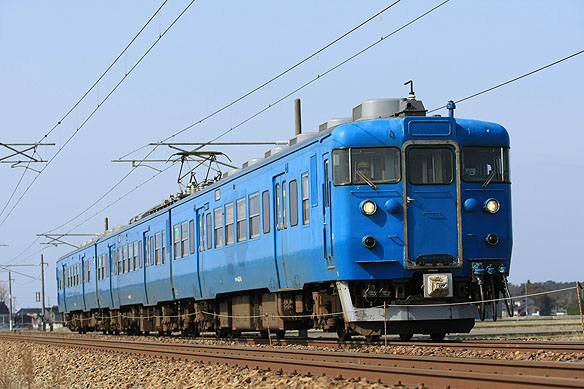Background and overview
Japanese National Railways (JNR) delivered life-expired dual-voltage electric
multiple unit (EMU) train, 475 series and 457 series, built for express
services into Hokuriku line in order to replace superannuated locomotive-hauled
coaches used on ordinary services in Hokuriku region in 1980s. But it was
inefficient economically to give life extension to superannuated 471 series
and it is impractical to build and deliver new vehicles. So, JNR delivered
413 series EMU. They were built by re-using the underframes, bogies and
electrical equipment from former 471 series EMUs with new suburban type
bodies based on the design of the 417 series EMUs introduced in 1978.
Some of trailer end cars were remodeled from class Saha455 intermediate
end cars by joining the cab section and classified into Kuha455-700.
Car body
The vehicle design incorporates ordinarily steel construction. They are
equipped with 2 double-leaf sliding doors on each side of the vehicles
and double-hung side windows with the upper stage descending and the lower
stage rising and door case windows. Door operating equipment is TK8A, which
can open/close manually to prevent the passenger's room from being cold
in winter. Motored vehicles are equipped with the equipments to remove
airborne snow from intake air. 6 air conditioners, AU13E rated at 5,500kcal/h,
are fitted on the end car's roof and an air conditioner, AU72 rated at
33,000kcal/h, is fitted on the centre of intermediate car's roof. Forced
ventilators are also fitted on the roof. Roller-binding destination screens
are fitted on the body. Their livery was red with the single white waistline
band running the length of each car below the windows.
Bogies
Bogies are DT32/TR69 transplanted from 471 series, featuring air spring.
Traction unit and ancillary equipments
Eight series-wound brushed DC traction motors, MT54, with a power output
of 120 kW are controlled by the armature-resistance traction control system,
CS15. The gear ratio is 4.82. Class Moha412 vehicles are equipped with
a transformer, TM20A, a rectifier, RS22, and a diamond-shaped current collector,
PS16H having the protection against snow and coldness. The roof where the
current collector is fitted, is lower than the other to make space for
insulation. Class Kuha412 vehicles are equipped with a motor generator,
MH128-DM85D with a power output of 110kVA, for the auxiliary power supply.
They adopt electromagnetic straight air brake with rheostatic brake.
Accommodation
Passenger accommodation consists of a mixture of transverse four-person seating bays and longitudinal bench seating. Their transverse seating bays were transplanted from 471 series. Class Kuha412 vehicles are equipped with a Japanese style toilet with a chemical holding tank. The air conditioning duct of class Moha412 is fitted above the ceiling in order to improve interior design.
Livery history
At the splitting of the former JNR into new privatized JR companies in
April 1987, JR West received all vehicles of 413-0 series. Their livery
was changed into white with the double blue waistline band running the
length of each car below the windows. Furthermore, they were repainted
into blue for Hokuriku line and red for Nanao line again.
Scrap
Although 413-0 series had been used on the ordinary services of Hokuriku
line, some vehicles were had transferred from JR-West ownership to the
third-sector railway operating company Ainokaze Toyama Railway, which took
over control of the section of the former Hokuriku Main Line within Toyama
Prefecture when it was separated from the JR-West network, coinciding with
the opening of the Hokuriku Shinkansen extension from Nagano to Kanazawa.
Then 413-0 series used on the ordinary services of the Hokuriku and Nanao
lines had been replaced with 521-100 series and withdrawn completely in
2021. |
|
| Technical Data |
| Items |
Data |
| Supply
Voltage |
20000VAC, 50/60Hz |
| Service
speed, etc. |
Service speed: 110km/h |
| Length |
19505mm |
| Width |
2950mm |
| Height |
4088mm |
| Bogie |
DT32B (motored) TR69B (trailer) |
| Collector |
PS16H |
| Traction
motor |
MT54B, MT54D (120kW) |
| Gear
ratio |
4.21 |
| Transformer |
TM20A |
| Rectifier |
RS22A |
| Traction system |
Armature-resistance control: (CS15) |
| Air
conditioner |
End cars: AU13E (5,500kcal×6), Intermediate cars: AU72 (33, 000kcal) |
| Designed
by |
Japanese National Railways |
|
|

